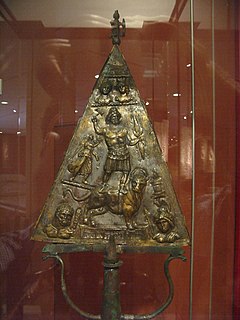The Cimbri were an ancient tribe in Europe. Ancient authors described them variously as a Germanic people, Celtic people, or even Cimmerian. Several ancient sources indicate that they lived in Jutland, which in some classical texts was called the Cimbrian peninsula. There is no direct evidence for the language they spoke, though some scholars argue that it must have been a Germanic while others argue that it must have been Celtic.

The Germanic peoples were a historical group of people living in Central Europe and Scandinavia. Since the 19th century, they have been traditionally defined by the use of ancient and early medieval Germanic languages and are therefore also called "Germanic-speaking peoples", although different academic disciplines have their own definitions of what makes someone or something "Germanic". The Romans named the area in which Germanic peoples lived Germania, which modern scholarship typically describes as stretching West to East between the Vistula and Rhine rivers and north to south from Southern Scandinavia to the Danube. The concept of the Germanic peoples has become the subject of controversy among modern scholars, with some calling for its total abandonment.

Mercury is a major god in Roman religion and mythology, being one of the 12 Dii Consentes within the ancient Roman pantheon. He is the god of financial gain, commerce, eloquence, messages, communication, travelers, boundaries, luck, trickery and thieves; he also serves as the guide of souls to the underworld.

The Treveri or Treviri were a Celtic tribe of the Belgae group who inhabited the lower valley of the Moselle from around 150 BCE, if not earlier, until their displacement by the Franks. Their domain lay within the southern fringes of the Silva Arduenna, a part of the vast Silva Carbonaria, in what are now Luxembourg, southeastern Belgium and western Germany; its centre was the city of Trier, to which the Treveri give their name. Celtic in language, according to Tacitus they claimed Germanic descent. They possibly contained both Gallic and Germanic influences.
The Vocontii were a Gallic people dwelling on the western foothills of the Alps during the Iron Age and the Roman period.

Intarabus was a Gaulish god in the pantheon of the Treveri and some neighbouring peoples. His name is known from nine inscriptions from a relatively compact area in what are now Belgium, Luxembourg, western Germany and eastern France. He may have been the tutelary deity of one of the three pagi (subdivisions) of the Treveri. In most cases, Intarabus is invoked alone – without any synthesis to a Roman deity, and without accompanying female deities. However, one inscription invokes him as Mars Intarabus, noting that a fanum and simulacrum of this god had been restored at Trier. Meanwhile, another inscription from Mackwiller in Alsace gives Intarabus the epithet Narius. An inscription at Ernzen in Germany has his name as [In]tarabus, while another from Foy-Noville, invokes Entarabus in conjunction with the Genius Ollodagus.

Jupiter Dolichenus was a Roman god whose mystery cult was widespread in the Roman Empire from the early-2nd to mid-3rd centuries AD. Like several other figures of the mystery cults, Jupiter Dolichenus was one of the so-called 'oriental' gods; that is Roman re-inventions of ostensibly foreign figures in order to give their cults legitimacy and to distinguish them from the cults of the traditional Roman gods.
The gens Acutia was a minor plebeian family at Ancient Rome. Members of this gens are mentioned from the early Republic to imperial times. The first of the Acutii to achieve prominence was Marcus Acutius, tribune of the plebs in 401 BC.
In classical antiquity, the Triboci or Tribocci were a Germanic people of eastern Gaul, inhabiting much of what is now Alsace.

The Heiligenberg is a large wooded hill overlooking the town of Heidelberg in Baden-Württemberg, Germany. It rises to around 440 metres NHN. It has been the site of many historic and pre-historic constructions, including a Celtic hilltop fortification, a Roman sacred precinct, several medieval monasteries, modern lookout towers and the Heidelberg Thingstätte, built by the Nazis in the 1930s.
In Roman historian Tacitus's first century CE book Germania, Tacitus describes the veneration of what he deems as an "Isis" of the Suebi. Due to Tacitus's usage of interpretatio romana elsewhere in the text, his admitted uncertainty, and his reasoning for referring to the veneration of an Egyptian goddess by the Suebi—a group of Germanic peoples—scholars have generally held that Tacitus's identification is incorrect, and have debated what goddess Tacitus refers to.
The Baetasii was the name Germanic tribal grouping within the Roman province of Germania Inferior, which later became Germania Secunda. Their exact location is still unknown, although two proposals are, first, that it might be the source of the name of the Belgian village of Geetbets, and second, that it might be further east, nearer to the Sunuci with whom they interacted in the Batavian revolt, and to the Cugerni who lived at Xanten. The area of Gennep, Goch and Geldern has been proposed for example.
The Germani cisrhenani, or "Left bank Germani", were a group of Germanic peoples who lived west of the Lower Rhine at the time of the Gallic Wars in the mid-1st century BC.

The numerus Batavorum, also called the cohors Germanorum, Germani corporis custodes, Germani corpore custodes, Imperial German Bodyguard or Germanic bodyguard was a personal, imperial guards unit for the Roman emperors of the Julio-Claudian dynasty composed of Germanic soldiers. Although the Praetorians may be considered the Roman Emperor's main bodyguard, the Germanic bodyguards were a unit of more personal guards recruited from distant parts of the Empire, so they had no political or personal connections with Rome or the provinces.

The Aresaces were Belgic tribe. They were closely related to, and probably originally part of, the Treveri. They inhabited the left bank of the Rhine in the Mainz-Bingen area, which was once the easternmost part of Treveran territory.
Lucius Acilius Strabo was a Roman senator active during the first century AD. He was suffect consul for the nundinium September-October 80 as the colleague of Sextus Neranius Capito. He is known entirely from inscriptions.

Mercurius Hranno is a Germanic god, who is only occupied by a dedicatory inscription from the 2nd to 3rd century in Bornheim - Hümmerich. The Germanic nickname is associated with the Old Norse Odin legume Hrani in and out of him, that was worshiped by the dedicatory inscription of the Germanic Wodan / Odin by resident Ubii. Hranno means "rough guy, polterer" and alludes to a trait of the common Germanic god.
The gens Secundia was an obscure plebeian family at ancient Rome. This gens is known almost entirely from inscriptions, as none of its members held any of the higher offices of the Roman state.
The gens Severia was an obscure plebeian family at ancient Rome. No members of this gens appear in history, but many are known from inscriptions.
The gens Justinia was an obscure plebeian family at ancient Rome. No members of this gens are mentioned in ancient writers, but several are known from inscriptions, chiefly from Gaul and Germania.









